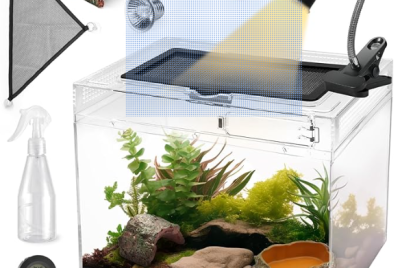Ultimate Guide to Cleaning and Maintaining a Bearded Dragon Tank
Owning a bearded dragon is rewarding, but keeping their habitat clean is one of the most important aspects of care. A well-maintained tank ensures your scaly companion stays healthy, comfortable, and free of harmful bacteria or debris. If you’re wondering how to master the art of tank cleaning, you’re in the right place. I’ll guide you step-by-step through daily, weekly, and monthly cleaning routines, share handy tips, and explain why these efforts are vital. Let’s dive in—your bearded dragon will thank you!
Why Regular Cleaning Is Crucial
A clean tank isn’t just about aesthetics—it directly impacts your bearded dragon’s health and happiness. Here’s why:
Understanding the Health Risks of an Unclean Tank
Bearded dragons are susceptible to diseases like respiratory infections or parasitic infestations if their habitat is dirty. A buildup of waste and leftover food promotes harmful bacteria and mold growth, which can be detrimental to their immune system.
Enhancing Your Bearded Dragon’s Comfort and Well-Being
A clean environment mimics their natural habitat and reduces stress. Your pet thrives in a tidy, odor-free space where they can move, bask, and hide without coming into contact with filth or waste. Think of it as their tiny kingdom—it’s your job to keep it pristine.
Tools You’ll Need for Cleaning
Having the right tools at your disposal makes cleaning a breeze.
Essential Cleaning Tools
- Scrub brushes for scrubbing surfaces like glass and decor.
- Paper towels or microfiber cloths for drying surfaces.
- Buckets or basins for soaking items.
- Latex gloves to protect your hands from bacteria and cleaning agents.
Pet-Safe Cleaning Products
- White vinegar or baking soda solutions for natural cleaning.
- Reptile-safe disinfectants that eliminate germs without harmful chemicals.
- Avoid regular household cleaners—they can be toxic to your bearded dragon.
Daily Maintenance Tasks
Taking a few minutes each day for basic maintenance keeps the tank hygienic between deeper cleans.
Spot Cleaning the Tank
Inspect the tank daily for waste, uneaten food, and debris. Use paper towels or gloves to remove droppings, preventing bacteria buildup.
Checking and Cleaning Water and Food Bowls
Empty and clean the water dish daily, as stagnant water can harbor bacteria. Rinse food bowls after feeding to avoid residue that attracts pests.
Weekly Cleaning Routine
Once a week, it’s time to roll up your sleeves and give the tank a deeper clean.
Deep Cleaning Surfaces
Remove decor, basking rocks, and branches to scrub them with warm water and reptile-safe cleaner. Wipe down glass walls with vinegar and water for a streak-free finish.
Replacing Substrate and Removing Waste
If you use loose substrate like sand or bark, replace it weekly to avoid bacteria and odor. For solid substrates like tiles, scrub and disinfect them to ensure cleanliness.
Monthly Tank Overhaul
A monthly deep clean ensures every nook and cranny of your bearded dragon’s habitat is spotless.
Inspecting Decor and Equipment
Check basking rocks, branches, and hides for wear or damage. Sand or replace rough edges to prevent injuries. Electrical equipment like lights and heaters should also be inspected for proper functionality.
Disinfecting the Entire Tank
Empty the tank completely, placing your bearded dragon in a safe temporary enclosure. Use a reptile-safe disinfectant to thoroughly clean every surface, including the walls, floor, and all decor. Allow everything to air dry before reassembling.
How to Safely Remove Your Bearded Dragon
Taking your pet out of their habitat during cleaning can be stressful for them—here’s how to do it right.
Preparing a Temporary Enclosure
Set up a secure, temporary habitat with a comfortable temperature and hiding spot. This keeps your bearded dragon safe and stress-free while you clean.
Handling Tips to Reduce Stress
Always handle your bearded dragon gently, supporting their body with both hands. Avoid sudden movements, as they can become startled. Speak softly to reassure them, and limit handling time to avoid unnecessary stress.
Cleaning Techniques for Different Materials
Different parts of your tank require specific cleaning approaches to maintain their longevity and safety.
Glass Tanks
Use a vinegar and water solution to clean glass panels. Scrub with a soft cloth or sponge to prevent scratches, then dry with a microfiber towel for a clear finish.
Rocks, Branches, and Other Decor
Soak rocks and branches in hot water to loosen dirt and kill bacteria. For stubborn grime, a stiff brush works wonders. Avoid harsh chemicals as they can linger and harm your pet.
Choosing the Right Substrate
The substrate is your dragon’s flooring, and keeping it clean is crucial.
Substrate Options and Their Pros/Cons
- Sand: Natural-looking but can harbor bacteria and cause impaction if ingested.
- Tiles: Easy to clean, durable, and hypoallergenic.
- Paper Towels: Budget-friendly but less aesthetic.
Cleaning vs. Replacing Substrate
For loose substrates, replace weekly or spot-clean daily. Solid substrates like tiles can be scrubbed and reused, making them a low-maintenance choice.
Preventing Odors and Stains
A clean tank shouldn’t just look good—it should smell fresh, too!
Tips to Maintain a Fresh-Smelling Tank
Remove waste daily and clean food bowls to prevent lingering odors. Regularly disinfect surfaces with reptile-safe products to eliminate bacteria that cause smells.
Treating Tough Stains
For stubborn stains on glass or decor, a mix of baking soda and water works as a gentle abrasive. Apply, scrub, and rinse thoroughly to restore the surface to its original state.
Common Mistakes to Avoid
Mistakes during cleaning can compromise your pet’s health and safety. Let’s steer clear of these pitfalls.
Using Harmful Cleaning Agents
Household cleaners with chemicals like bleach or ammonia can harm your bearded dragon. Always opt for reptile-safe alternatives.
Ignoring Hidden Spots
Areas like underneath decor, inside hides, or behind the tank walls can accumulate grime. Pay attention to these hidden spots during deep cleans.
Creating a Cleaning Schedule
A regular cleaning routine ensures a healthy habitat and less overwhelming tasks.
Tailoring a Routine to Your Bearded Dragon’s Needs
Adjust your schedule based on the size of the tank and your pet’s habits. A smaller enclosure or messier dragon may require more frequent cleaning.
Combining Tasks for Efficiency
Align daily, weekly, and monthly cleaning tasks with feeding or handling routines to save time and maintain consistency.
Signs Your Tank Needs Immediate Attention
Sometimes, your tank might need urgent cleaning outside the regular schedule. Be alert to these red flags:
Health Indicators in Your Bearded Dragon
If your bearded dragon shows signs of respiratory issues like wheezing or lethargy, it could be due to poor tank hygiene. Similarly, frequent shedding problems may indicate bacteria or humidity issues in the habitat.
Visual Signs of Tank Issues
Accumulated droppings, mold growth, or foul odors are immediate calls for action. Address these problems promptly to prevent harm to your pet.
Environmental Factors to Monitor Post-Cleaning
After cleaning, it’s essential to restore the tank to its ideal conditions to keep your bearded dragon comfortable.
Ensuring Proper Temperature and Humidity
Cleaning can temporarily disrupt the tank’s temperature or humidity. Use thermometers and hygrometers to ensure levels are back to normal before reintroducing your dragon.
Resetting Decor and Hiding Spots
Place decor back thoughtfully to recreate familiar hiding and basking spots. A predictable layout reduces stress and makes your pet feel at home again.
Conclusion
Cleaning a bearded dragon’s tank may seem like a chore, but it’s a vital part of being a responsible pet owner. Regular maintenance keeps your dragon healthy, happy, and comfortable while extending the lifespan of their habitat. By following the daily, weekly, and monthly routines outlined above, you can create a hygienic and welcoming environment for your pet. Remember, consistency is key—once you establish a rhythm, it becomes second nature. Your bearded dragon depends on you, so let’s keep their home sparkling clean!
FAQs
1. How often should I clean my bearded dragon’s tank?
Daily spot cleaning is essential, with a more thorough weekly cleaning and a complete tank overhaul once a month.
2. Can I use regular household cleaners for the tank?
No, household cleaners often contain chemicals harmful to reptiles. Always use reptile-safe cleaning products or natural solutions like diluted vinegar.
3. What’s the best substrate for easy cleaning?
Tiles or reptile carpet are easy to clean and highly recommended for maintaining hygiene. Loose substrates like sand require more frequent replacement.
4. How can I keep my bearded dragon stress-free during cleaning?
Handle them gently, provide a temporary enclosure with a familiar hiding spot, and limit the duration of cleaning.
5. What should I do if I notice mold or persistent odors in the tank?
Immediately remove the affected substrate or decor. Disinfect the tank thoroughly with a reptile-safe solution, and ensure proper ventilation to prevent recurrence.




